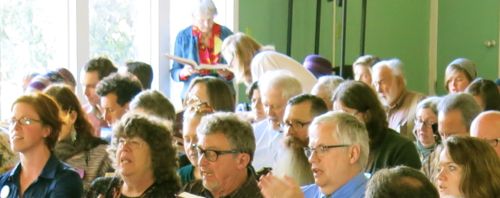
These are the eggs that Carol dyed last night, and which we brought to church this morning to be eaten during the annual Easter egg hunt.
Yet Another Unitarian Universalist
A postmodern heretic's spiritual journey.

These are the eggs that Carol dyed last night, and which we brought to church this morning to be eaten during the annual Easter egg hunt.
Even though I’m the guy who wrote the essay “Why I Don’t Pray” in the pamphlet “UU Views of Prayer,” I’ve been thinking a lot about prayer recently. Not because I’ve started praying (I haven’t), but more because I’m sick of hearing about the alleged virtues of meditation and mindfulness. You see, meditation and mindfulness are being coopted by consumer capitalism: Meditation will improve worker productivity! Mindfulness will help your children get better grades! And if you work more, or get good grades and go to college, you will be able to buy more!
These are fairly recent developments for meditation and mindfulness. Prayer, on the other hand, got coopted by consumer capitalism a few decades ago. Prayer is an integral part of the “Prosperity Gospel,” a mutant offspring of Christianity and consumer capitalism which holds that if you believe in God and pray and give generously to your church then you will get rich. While I try to be tolerant of other people’s religious beliefs, the Prosperity Gospel is bullshit. And it’s clear clear to me that meditation and mindfulness are on track to being coopted in the same way prayer was: soon we will faced with the spectre of the Prosperity Dharma.
Unitarian Universalists have developed some standards and best practices that have tended to insulate us from the worst excesses of the Prosperity Gospel. It is worth reviewing what those are:
1. Prayer is not going to make you rich; some people who pray might get rich, but that’s random chance. (In fact, the same can be said of religion in general.)
2. If prayer works for you, go for it. If prayer doesn’t work for you, then don’t — AND don’t be an asshole and make fun of people who find that prayer works for them.
3. Unitarian Universalists generally agree with Jesus when he says in the Bible, “When you pray, do not be like the hypocrites, for they love to pray on the street corners to be seen by others” (Matt. 6:5). In other words, it’s fine if you pray but don’t be a show-off. In fact, don’t be a show-off with any spiritual practice.
4. We do not have to bow our heads during prayer (see previous point). If you want to, that’s fine, but you don’t have to.
Why is it worth reviewing these standards and best practices? Because they can also be applied to meditation and mindfulness. And meditation and mindfulness are coming ever closer to breeding their own mutant offspring with consumer capitalism. And the last thing we need is to be taken over by the Prosperity Dharma.
In the United States, all too often the phrase “religion in the public square” means someone accosting you and telling you that you should join their religion; so the meaning of the phrase becomes, “our religion is right and yours is wrong.” Or that same phrase can be used pejoratively to imply that all religious practice shouldb e kept out of public view; so the meaning of the phrase becomes, “all religion is wrong.” Either way, someone is imposing their own views on the rest of a democratic society.
But if ours is a truly multicultural democracy, we should allow space in the public square for a variety of worldviews, without letting any one worldview dominance over the others. This becomes a delicate balancing act. Literal or metaphorical shouting matches between religious worldviews don’t promote tolerance; mind you, sometimes you have to get into shouting matches to preserve the openness of the public square, as when we have to fight to limit Christmas displays on public property, but no one imagines that these shouting matches increase tolerance. So given that public religious expression is a delicate balancing act, what does it look like when you have an appropriate expression of a religious worldview in the public square?
Today I saw such an expression of a religious worldview in the public square, and it looked like a rented flatbed trailer with a sukkah built on top of it. The trailer was parked in front of the Jewish Learning Institute of San Francisco (JLISF), on Lombard Ave. right off busy Columbus Ave in the North Beach neighborhood. Carol and I walked by just as some people from JLISF were cleaning up from lunch. They were polite and friendly, and ready to explain that they were celebrating Sukkot, and what a sukkah was, and so on.
This is a good display of religion in the public square: present, but not intrusive; with friendly people who are ready to explain, but not berate.
(Posted the next day, and backdated.)
This week I’ve been posting images of deities. But what is a deity, anyway?
Here in the United States, popular culture has been heavily influenced by Protestant Christian culture, and so when we are asked to define a deity, we default to the concept of a monotheistic transcendent deity. If we have to draw a picture of this deity, we might either draw a picture of a man with a white beard sitting on a cloud, or say that this deity is transcendent and can’t be pictured.
However, most of the human race, for most of human history, has had a far more complex and nuanced understanding of deities. In our own Western cultural tradition, which extends back to the civilizations of Rome, Greece, and the ancient Near East more generally, we can find a great diversity of deities. Here’s a list of some of the categories of deity we can identify in the Western religious traditions:
• a single transcendent deity, e.g., the transcendent god of Xenophanes and other early Greek philosophers; God for some Jews; God the Father for some Christian sects
• a most powerful deity among other deities, e.g., Zeus in ancient Greece
• greater deities, e.g., the more powerful ancient Egyptian deities such as Horus, Osiris, and Ra
• lesser deities, e.g., the Titans in ancient Greece
• local deities, e.g., river gods, deities of a grove or forest, etc.
• household deities, e.g., the household gods of ancient Rome, etc.
• deified humans, e.g., the ancient Egyptian Pharaoh, Roman emperors deified after death, etc. (some might argue that the Virgin Mary of some Christian sects fits into this category)
• humans that are more than mortal but slightly less than gods, e.g., Herakles for the ancient Greeks, Jesus for the Christian followers of Arius, etc.
• humans with special powers who are worthy of veneration, e.g., canonized saints, sports figures and celebrities, etc.
• abstract concepts as deities, e.g., god as the unmoved mover in Aristotle, scientific method, financial success, etc.
These are just the first examples from the Western religious traditions that come to my mind. Then we can add in all the deities which are current in our increasingly multicultural world, such as the vast hierarchy of Hindu deities, the several Buddhas (who may appear as humans with special powers, but who may also appear as transcendent deities), ancestors who are venerated (as in some African traditions), deities as part of nature or tied to natural places (as with some Navajo deities), etc., etc.
I don’t believe we should accept without question the U.S. Protestant Christian definition of deity as a single transcendent god in whom one either believes or doesn’t believe. Humans in the U.S. today venerate a variety of deities, many of which look nothing like the U.S. Protestant transcendent God. And that veneration can take a variety of forms, from overt public worship to more covert forms of veneration. Given that, don’t you think that there is a lot more religion in the U.S. today than is captured by polls which ask whether people believe in “God” and attend “church”?
On the Sacred Harp Friends page on Facebook, Katie posted a link to a blog post by Thom Schulz, titled “Why They Don’t Sing on Sunday Anymore.” Schulz’s reasons why people don’t sing in church: too often services are spectator events; church music is dominated by professionals, to the point of squeezing us amateurs out; sometimes the volume gets cranked up so high people just stop singing; the hymns are unfamiliar or hard to sing.
Katie then noted that Sacred Harp singers do sing, and we sing fervently — because there are no spectators, there are no professionals, it’s loud but not deafening, and Sacred harp singers have been singing pretty much the same tunes for a century and a half.
Actually, in my church people do sing. Amy, the senior minister, and I made a pact some years ago that the first hymn would mostly get chosen from a pool of ten or so hymns; that way, the kids can memorize ten or so hymns and know them by heart. And indeed the kids (and the adults) do memorize those hymns, and they do sing with fervor and gusto. In one recent service, I watched as one of our more cynical upper elementary kids stood on a chair, hung on to dad, and sang with utter abandon; cynicism gone, this child was completely lost in the hymn.
Given my experience, I’m with Thom Schulz: congregational singing does not need spectators, over-professionalism, blare, or crappy songs. Congregational singing can aim towards joy, towards ecstatic union with the universe through song. Congregational singing can be — should be — cynical kids belting out a favorite hymn at the tops of their voices, completely lost in the moment.

This past Sunday, the middle school ecojustice Sunday school class cooked on rocket stoves. We based our stoves on design principles developed by Dr. Larry Winiarski, who is affiliated with the Aprovecho Research Center. A rocket stove makes more efficient use of biomass fuels (wood, twigs) through more complete combustion; this also results in fewer harmful emissions. According to the Aprovecho Research Center:
“Improved cooking stoves address at least 5 of the 8 United Nations’ Millennium Development Goals: [1] ending poverty and hunger; [2] gender equity; [3] child health; [4] maternal health; and [5] environmental sustainability.”
So while we don’t really need rocket stoves here in the Bay area (except perhaps in disaster situations), learning about and building them is a great introduction to using appropriate technology to meet ecojustice goals of human well being and environmental sustainability.
If you’re not familiar with rocket stove design principles,Aprovecho Research Center has an excellent introduction on this Web page. Scroll down and click on document no. 8, “Design Principles for Wood Burning Cook Stoves,” June, 2005.
Enough background. Here are instructions for building a concrete block rocket stove, followed by photos of our rocket stove in action:
Click the image above for a drawing of how to build our concrete block rocket stove. You will find other plans for a concrete block rocket stove on the Web, but those plans typically require a concrete h-block, an oddball type of block that we were unable to find. However, most bit home improvement stores carry 8 x 2 x 16 inch concrete cap blocks, and 4 x 2 x 8 inch concrete brick — two cap blocks and two concrete brick can be arranged in an “H” shape to make a stove. In fact, this is a better solution than a concrete H-block, because you can adjust the concrete brick such that you have a constant cross-sectional area throughout the L-shaped combustion chamber (see “Design Principles for Wood Burning Cook Stoves,” principle 7).

Above: The concrete block rocket stove after use. We placed two concrete bricks on the top on which to place cooking implements, etc. The bottom concrete block serves as a convenient place to store fire wood. Notice that our firewood is all salvaged building materials and wood pallets, split to appropriate size for burning.

Above: Cooking on the stove. “Design Principles for Wood Burning Cook Stoves” states that a combustion chamber with a 12 x 12 cm cross sectional area is “usually sufficient for a family sized cooking stove.” Our concrete block rocket stove has a cross sectional area of 12.5 x 15 cm. It put out a good amount of heat for cooking scrambled eggs for half a dozen people. Note that one person is feeding the fuel into the stove, while the other cooks — we found it was challenging to cook and tend the fire at the same time.
We did not try to boil water on our concrete block rocket stove, to see how long that would take. Maybe that’s a task for a future class.
Update, one year on: This has proved to be a good, but not excellent, rocket stove design. The chief problem with this design is that the concrete block acts as a fairly large thermal mass, and it takes a while to heat the block. Once the block is warm, the stove functions pretty efficiently; while the block is still cook, it’s not as good. Another problem is that the stove is finicky, and requires constant attention to feeding fuel in order to maintain a fairly constant temperature. Nevertheless, given the low cost of materials, and the ease of construction, this remains a practical design.
Mindi convened a session at UNCO 14 on writing as a spiritual practice, and as a way to make money. Participants in this session included several bloggers, a novelist or two, and nonfiction writers writing about contemporary religion. We talked a bit about the mechanics of the publishing world, and the pleasures of writing, but what interested me most was to hear about the writing projects people were working on or contemplating.
And I felt the most interesting writing project anyone described was a memoir by an unchurched young adult who became a progressive Christian. We hear too much from people who leave organized religion (usually in a huff), and from people who convert (often loudly and spectacularly) to conservative Christianity — it’s about time we heard from a None who became a religious progressive.
We also talked about how to make money writing. Carol said one editor told her that since 2008, books sell about half as many copies and make about half as much money as they used to make. Beyond books, no one seemed to have a good plan for monetizing a blog. There was quite a bit of talk about niche markets, and how to reach them. One final tip from this workshop: Mindi said that many agents use the Twitter hastag #mswl to request manuscripts on specific topics.
Derrick convened a very helpful UNCO session on self care for pastors. As the 15 pastors who were present talked about this issue, one thing stood out for me: most congregations may be willing to hear about the health issues of their pastor, except they mostly don’t want to hear about any mental health issues their pastor may have. If a pastor is struggling with, e.g., depression, do they dare to tell their congregation about this health issue? Probably not. Since ministers are at higher risk for the mental health issues of depression and substance abuse, this is a bit of a problem.
On the other hand, I get the feeling that many ministers don’t want to talk about mental health issues until they are actually facing trouble. In my opinion, ministers should have an ongoing relationship with a mental health professional, e.g., I talk every month with someone who is both a congregational consultant and a licensed family therapist. If a minister has such an ongoing relationship, if they do develop mental health problems they have someone they can turn to immediately; they also have someone who can help them identify a growing problem and get treatment before the problem affects work or personal life. Perhaps congregations could take more responsibility for their minister’s mental health by requiring and funding regular consultations with a therapist.
During the UNCO 14 session on ecclesiology and entrepreneurship, convened by my old friend Ms. M, I got to hear a little about innovative ministries, and innovative approaches to ministry, that UNCO participants are engaging in right now. Some of these innovative ministries are outside traditional congregations; some are innovating within traditional congregations. But it seemed like all of us are trying to figure out how to find money to fund these ministries.
Mindi, who is working part-time in a traditional congregation and part-time in a non-traditional start-up ministry, pointed out that the old donation model — asking church members to donate money to their congregation — is on its last legs. What will take its place? Amy said her new non-traditional congregation has a business model where worship services are open and free, and everything else is on a fee-for-service basis; they still solicit donations, but donations will go to allow sliding-scale payment for the fee-for-service programs. A number of people talked about using crowd-sourced funding. Anna said she will be trying patreon.com, a platform for crowd-sourcing ongoing funds for arts projects through a monthly payment scheme, to fund her non-traditional arts-based congregation — she said she’ll let us know how that goes. Jeff said he had tried Kickstarter, and had had less then stellar results.
During this session, we talked quite a bit about using capitalist methods to fund organized religion. Should we just accept that consumer capitalism is our cultural milieu, and use it to fund good projects? Or should we in organized religion stay in tension (to a greater or lesser degree) with consumer capitalism? Carol argued for staying in tension with capitalism; Amy seemed to not worry about it, focusing instead on the good she could do by using consumer capitalist techniques. While this discussion was going on, I was asking myself: If the old donation model is over, what’s our theology for new funding sources? — this is the question at the heart of an ecclesiology of entrepreneurship.
“Ministry to and with children and youth often gets the left-overs of pastoral attention … [yet] ‘the last and the least’ should be the first and greatest in pastoral priorities.”
Brian McLaren, recommending the book Faith Forward: A Dialogue on Children, Youth, and a New Kind of Christianity.